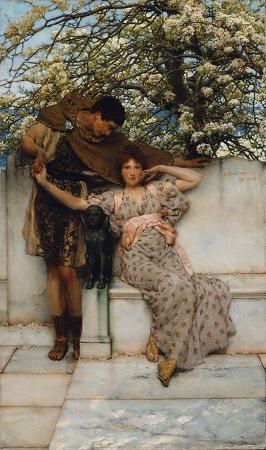John William Godward (1861 - 1922). John William Godward was an English painter from the end of the Neo-Classicist era. He was a protégé of Sir Lawrence Alma-Tadema, but his style of painting fell out of favor with the rise of modern art. He committed suicide at the age of 61 and is said to have written in his suicide note that the world is not big enough for myself and a Picasso. His estranged family, who had disapproved of his becoming an artist, were ashamed of his suicide and burned his papers. Only one photograph of Godward is known to survive. Godward was born in 1861 and lived in Wilton Grove, Wimbledon. He was born to Sarah Eboral and John Godward. He was the eldest of five children. He was named after his father John and grandfather William. He was christened at St. Mary's Church in Battersea on 17 October 1861. The overbearing attitude of his parents made him reclusive and shy later in adulthood. He exhibited at the Royal Academy from 1887. When he moved to Italy with one of his models in 1912, his family broke off all contact with him and even cut his image from family pictures. Godward returned to England in 1921, died in 1922, and is buried in Brompton Cemetery, West London. One of his best-known paintings is Dolce far Niente, which was purchased for the collection of Andrew Lloyd Webber in 1995. As in the case of several other paintings, Godward painted more than one version; in this case, an earlier 1897 version with a further 1906 version. Godward was a Victorian Neo-Classicist, and therefore, in theory, a follower of Frederic Leighton. However, he is more closely allied stylistically to Sir Lawrence Alma-Tadema, with whom he shared a penchant for the rendering of Classical architecture, in particular, static landscape features constructed from marble. The vast majority of Godward's extant images feature women in Classical dress posed against landscape features, although there are some semi-nude and fully nude figures included in his oeuvre, a notable example being In The Tepidarium, a title shared with a controversial Alma-Tadema painting of the same subject that resides in the Lady Lever Art Gallery. The titles reflect Godward's source of inspiration: Classical civilization, most notably that of Ancient Rome. Given that Classical scholarship was more widespread among the potential audience for his paintings during his lifetime than in the present day, meticulous research of detail was important in order to attain a standing as an artist in this genre. Alma-Tadema was an archaeologist as well as a painter, who attended historical sites and collected artifacts he later used in his paintings: Godward, too, studied such details as architecture and dress, in order to ensure that his works bore the stamp of authenticity. In addition, Godward painstakingly and meticulously rendered other important features in his paintings, animal skins and wildflowers. The appearance of beautiful women in studied poses in so many of Godward's canvases causes many newcomers to his works to categorize him mistakenly as being Pre-Raphaelite, particularly as his palette is often a vibrantly colorful one. The choice of subject matter is more properly that of the Victorian Neo-classicist. However, it is appropriate to comment that in common with numerous painters contemporary with him, Godward was a 'High Victorian Dreamer', producing beautiful images of a world which, it must be said, was idealized and romanticized, and which in the case of both Godward and Alma-Tadema, came to be criticized as a world-view of 'Victorians in togas'. Godward quickly established a reputation for his paintings of young women in a classical setting and his ability to convey with sensitivity and technical mastery the feel of contrasting textures, flesh, marble, fur and fabrics. Godward's penchant for creating works of art set in the classical period probably came from the time period in which he was born. The last full-scale classical revival in western painting bloomed in England in the 1860s and flowered there for the next three decades.
more...













